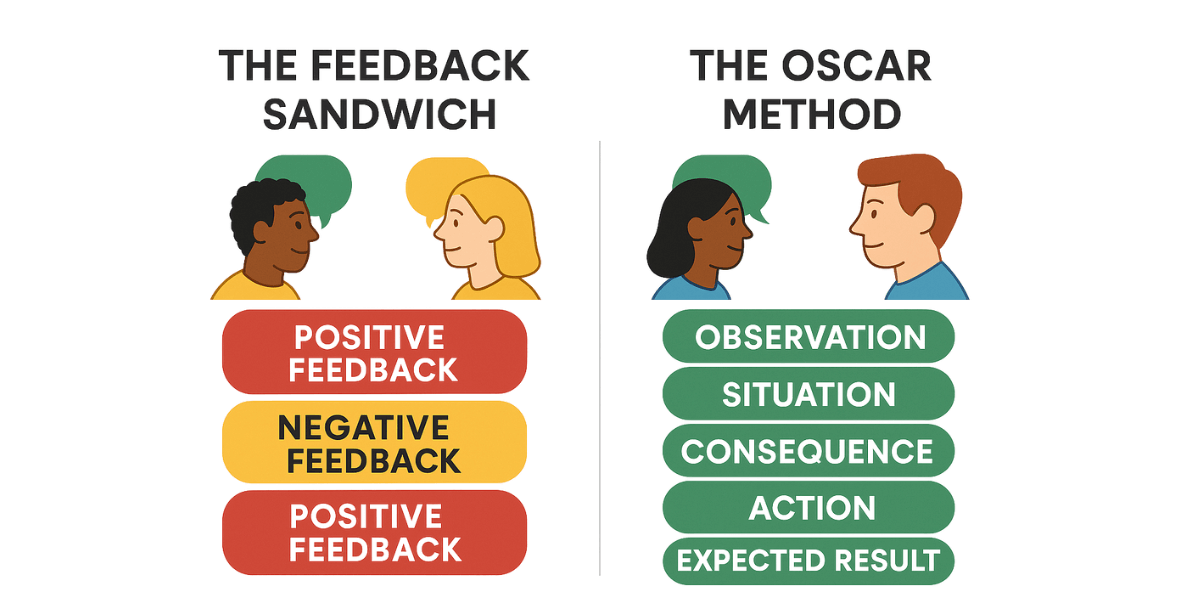Home > Feedback Culture: Engagement and Pitfalls to Avoid
What if your company was stagnating due to poor communication? Too often overlooked, feedback culture plays a key role in employee engagement, talent retention, and continuous improvement. But it must be implemented effectively and without the mistakes that undermine it. In this article, discover why building a strong feedback culture can transform your organization, and how to apply it practically while avoiding common pitfalls.

Feedback culture is a climate where every team member feels free to share insights positive or critical without hierarchical barriers. Picture an environment where recognition and improvement suggestions flow as naturally as water in a stream. According to a Human Resource Management study, this dynamic is built on three pillars: mutual trust, psychological safety, and regular communication.
| Key indicator | Before implementation | After implementation |
|---|---|---|
| Employee satisfaction | 56% of employees feel unrecognized | Significant increase thanks to constructive feedback |
| Turnover rate | High talent turnover | 14.9% decrease in proactive companies |
Unlike the dreaded annual review, continuous feedback works like a professional GPS. Take the example of a tech SME: its weekly “quick feedback” meetings reduced interdepartmental misunderstandings by 40% in six months.

Did you know that 70% of team conflicts stem from unresolved issues and unspoken concerns? A strong feedback culture acts as a healthy outlet. At Google, managers trained in targeted feedback techniques saw their teams achieve 30% more goals.
The benefits also show in retention: Millennials stay twice as long in companies where their voices are truly heard. A virtuous cycle emerges: better communication → increased engagement → boosted performance.
Beware of the poorly executed “feedback sandwich”! This classic format (positive/negative/positive) can backfire if the praise feels fake. Instead, use the OSCAR method: Observation, Situation, Consequence, Action, Expected Result.
Another common pitfall: neglecting follow-up. 65% of employees consider feedback pointless without a concrete action plan. The key? Turn each feedback into a SMART micro-task (Specific, Measurable, Achievable, Realistic, Time-bound).
And remember: effective feedback is neither a personal critique nor a vague compliment. It’s a clear signal guiding collective excellence.

Start with an honest assessment: does your company tend to give “red light” feedback (urgent and stressful) or “green light” feedback (constructive and regular)? This starting point will shape your roadmap. As highlighted in our team management fundamentals training, leadership by example is the fuel for lasting change.
Essential tools to get started:
Knowing how to speak without triggering defensiveness takes practice! Prioritize short modules that combine theory (DESC method) with simulations. A preliminary skills analysis often reveals gaps in active listening and emotional intelligence.
Special case: multicultural teams. Direct feedback valued in the U.S. might offend in Asia. The solution? Train employees in intercultural communication and use universal visual tools like mood emojis.
| Quantitative | Qualitative |
|---|---|
| +80% monthly feedback increase | Feeling of being heard |
| 1 feedback/week per manager | Quality of hierarchical relationships |
Don’t forget: a feedback culture evolves like a muscle it needs regular training! Every quarter, bring together a “feedback ambassadors council” to refine the process. And if your direct manager is hesitant? Suggest reverse feedback using the “3 stars and 1 wish” method.

The secret? Structure feedback like a recipe. The DESC method (Describe, Express, Specify, Consequences) turns criticism into an action plan. Example: “I noticed the report included outdated data (D), which could harm our client credibility (E). Could you verify sources before next Wednesday (S)? This would help us avoid delayed payments (C).”
The famous “feedback sandwich” (positive/negative/positive) remains popular, but beware the whipped cream effect! One study found that 43% of employees view these praise-wrapped comments as insincere. Prefer the COIN model: Context (set the scene), Observation (state the fact), Impact (explain the effect), Next steps (suggest solutions).
| Tool | Main benefit | Best for |
|---|---|---|
| 15Five | Automated weekly check-ins | Growing SMEs |
| Culture Amp | Advanced analytics | Large enterprises |
| Officevibe | Guaranteed anonymity | Sensitive environments |
These tools integrate seamlessly like the missing piece of the puzzle. Slack or Teams become natural spaces for informal feedback. A tip: start with a simple tool before deploying complex systems. Tech overload often kills team engagement!
Final tip: the “one-minute feedback” during meetings. Each participant shares 1 compliment and 1 suggestion to improve future sessions. You’ll feel the energy shift in just 3 meetings!

Take the example of Geneva-based company Infomaniak, a recognized player in cloud and web hosting. In 2022, their HR team launched an internal initiative called “Feedback Friday”, combining weekly anonymous feedback, inter-team sharing workshops, and personalized coaching for managers. In less than a year, internal engagement scores rose by 28 points, and voluntary turnover dropped by 18%.
This dynamic also uncovered hidden internal talent: four employees were promoted thanks to peer feedback received during these sessions. One of them shared: “It was the first time I truly felt heard without having to go through three levels of management.”
Their success rests on two pillars: transparent communication and the integration of regular rituals. As their COO put it: “Feedback has become our collective mirror. It helps us see ourselves better to move forward.”
A concrete example is that of the Services Industriels de Genève (SIG). During the implementation of the “New Ways of Working” (NWOW) project, SIG undertook an organizational transformation aimed at establishing a feedback culture and increasing employee autonomy. However, the initiative faced significant challenges.
According to Robert Monin, HR Director at SIG, some managers were not ready to adopt a new leadership mindset centered on feedback and autonomy. He noted that “some managers simply lack the skills to initiate this change in posture.” This highlighted the critical importance of training and supporting managers throughout the cultural transformation process.
Recurring pitfalls to absolutely avoid:
The SIG experience shows that without strong leadership commitment and proper manager preparation, initiatives to build a feedback culture may fail. To overcome these challenges, SIG introduced training and coaching programs to help managers embrace their new roles, fostering a more open and collaborative company culture.
With remote work on the rise, instant feedback is becoming crucial. Tools like “virtual coffee breaks” with quick feedback sessions are emerging. AI now analyzes the tone of written feedback to detect underlying tension a revolution in HR management!
As for Gen Z, they’re rewriting the rules: 83% prefer asynchronous video feedback over formal reviews. The future is interactive, personalized… and unfiltered!
As you’ve seen, building a feedback culture boosts employee engagement, improves internal communication, and turns challenges into opportunities. To take action, start by training your managers in constructive feedback and use simple tools like regular check-ins. Tomorrow, your organization can thrive through this collaborative dynamic where every voice matters. The pace of change is accelerating now it’s your move!

What are the 3 types of feedback?
We distinguish positive feedback, which highlights success; corrective feedback, which suggests improvements; and negative feedback, which identifies specific issues. Together, they form constructive, progress-oriented feedback.
What are the 5 Rs of feedback?
The most common 5 Rs are: Request (ask for feedback), Receive (listen without justifying), Reflect (take a step back), Respond (take action), and Resolve (draw a useful conclusion).
How to tailor feedback to different profiles?
Take into account each person’s personality. A results-oriented individual will prefer direct feedback, while a sensitive person may appreciate a kind, private approach. The key is to be factual, clear, and respectful.
When should feedback be given?
The best time is as soon as possible after the relevant action. Feedback given in the moment has more impact. Positive remarks are best shared publicly; corrective ones should remain private.
What methods can be used to structure feedback?
The DESC and COIN methods help deliver clear, fact-based, action-oriented feedback. They prevent clumsy or vague criticism.
What tools help establish a feedback culture?
Solutions like 15Five, Culture Amp, and Officevibe make it easier to share feedback regularly, track responses, and analyze team engagement.

ITTA is the leader in IT training and project management solutions and services in French-speaking Switzerland.
Our latest posts
Subscribe to the newsletter

Nous utilisons des cookies afin de vous garantir une expérience de navigation fluide, agréable et entièrement sécurisée sur notre site. Ces cookies nous permettent d’analyser et d’améliorer nos services en continu, afin de mieux répondre à vos attentes.
Monday to Friday
8:30 AM to 6:00 PM
Tel. 058 307 73 00
ITTA
Route des jeunes 35
1227 Carouge, Suisse
Monday to Friday, from 8:30 am to 06:00 pm.